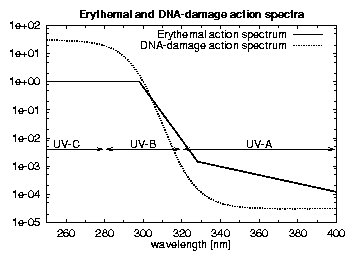Surface UV radiation monitoring based on GOME and SCIAMACHY
Jos van Geffen, Ronald van der A, Michiel van Weele, Marc Allaart and
Henk Eskes
in: Proceedings of the ENVISAT & ERS Symposium, 6-10 September 2004,
Salzburg, Austria, ESA publication SP-572, 2005 (CD-ROM).
2. UV radiation and action spectra
Ultraviolet light is usually divided into three components: UV-A
(320-400 nm), UV-B (280-320 nm) and UV-C (200-280 nm). The UV-C component of
the Solar UV light is potentially the most dangerous as it has the highest
energy levels, but this component is completely absorbed by ozone and oxygen
above about 30 km. The UV-B component is strongly absorbed by ozone, but a
small fraction reaches the Earth's surface. The UV-A is only weakly absorbed
by ozone, with some scattering of radiation near the surface.
Most of the UV radiation reaching the surface is therefore UV-A.
Due to the higher energy levels of UV-B, however, the UV-B component has
more effect on flora and fauna than UV-A. An action spectrum is a parameter
function which describes the relative effect of energy at different
wavelengths in producing a certain biological response. These effects may be
at a molecular level, such as DNA damage, or at the level of the whole
organism, such as plant growth. An action spectrum is used as a "weighting
function" for the UV spectrum in an integration of the monochromatic UV
irradiance.

|
Figure 1.
Action spectra of the susceptibility of the human skin to erythema (sunburn)
and of generalised DNA damage due to UV radiation. The erythemal UV index is
an integration between 280 and 400 nm of the UV irradiance at ground level,
weighted with the erythemal action spectrum. The DNA-damage UV index is an
integration between 256 and 370 nm of the UV irradiance at ground level,
weighted with the DNA-damage action spectrum.
|
For the TEMIS data service the two action spectra illustrated in
Fig. 1 are used:
-
The CIE action spectrum for erythema (reddening of the skin due to sunburn),
proposed by McKinlay & Diffey [5]
and adopted as a standard
by the Commission Internationale de l'Éclairage (International
Commission on Illumination).
-
An action spectrum for generalised DNA-damage, which has been determined by
Setlow [6] and was parametrised by Bernard and Seckmeyer [7].
These action spectra stress the importance of the UV-B component.
Of the global UV irradiance at the surface, 94% is UV-A and 6% is UV-B.
Whereas of the erythemal UV irradiance at the surface, for example,
17% is UV-A and 83% is UV-B.
<=== contents of this paper
===> references
<=== Publications page
<=== Post-doc. research at KNMI page
 Jos van Geffen --
Home |
Site Map |
Contact Me
Jos van Geffen --
Home |
Site Map |
Contact Me
created: 3 September 2004
last modified: 19 August 2020
 Jos van Geffen --
Home |
Site Map |
Contact Me
Jos van Geffen --
Home |
Site Map |
Contact Me